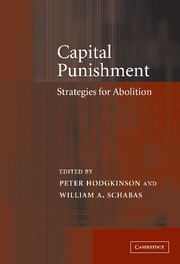Book contents
- Frontmatter
- Contents
- List of figures
- List of tables
- Notes on the contributors
- 1 Capital punishment: improve it or remove it?
- 2 International law and the death penalty: reflecting or promoting change?
- 3 Doctors and the death penalty: ethics and a cruel punishment
- 4 Replacing the death penalty: the vexed issue of alternative sanctions
- 5 Religion and the death penalty in the United States: past and present
- 6 On botched executions
- 7 Death as a penalty in the Shari'ā
- 8 Abolishing the death penalty in the United States: an analysis of institutional obstacles and future prospects
- 9 Capital punishment in the United States: moratorium efforts and other key developments
- 10 The experience of Lithuania's journey to abolition
- 11 The death penalty in South Korea and Japan: ‘Asian values’ and the debate about capital punishment?
- 12 Georgia, former republic of the USSR: managing abolition
- 13 Capital punishment in the Commonwealth Caribbean: colonial inheritance, colonial remedy?
- 14 Public opinion and the death penalty
- 15 Capital punishment: meeting the needs of the families of the homicide victim and the condemned
- Index
12 - Georgia, former republic of the USSR: managing abolition
Published online by Cambridge University Press: 22 September 2009
- Frontmatter
- Contents
- List of figures
- List of tables
- Notes on the contributors
- 1 Capital punishment: improve it or remove it?
- 2 International law and the death penalty: reflecting or promoting change?
- 3 Doctors and the death penalty: ethics and a cruel punishment
- 4 Replacing the death penalty: the vexed issue of alternative sanctions
- 5 Religion and the death penalty in the United States: past and present
- 6 On botched executions
- 7 Death as a penalty in the Shari'ā
- 8 Abolishing the death penalty in the United States: an analysis of institutional obstacles and future prospects
- 9 Capital punishment in the United States: moratorium efforts and other key developments
- 10 The experience of Lithuania's journey to abolition
- 11 The death penalty in South Korea and Japan: ‘Asian values’ and the debate about capital punishment?
- 12 Georgia, former republic of the USSR: managing abolition
- 13 Capital punishment in the Commonwealth Caribbean: colonial inheritance, colonial remedy?
- 14 Public opinion and the death penalty
- 15 Capital punishment: meeting the needs of the families of the homicide victim and the condemned
- Index
Summary
The issue of the abolition of capital punishment is complex and must be addressed in the context of historical, legal, moral, criminological, economic, educational and other factors, and, because of this, there is scope for difference in this universal process. The objective of this chapter is to describe Georgia's experience and thus to give an example of national particularities. For context, it is necessary to mention that Georgia, a country of some 70,000 square kilometres with a population close to five million, is situated in the Transcaucasus between Russia and Turkey.
The history of the death penalty in Georgia is both interesting and important. The first abolition of the death penalty took place as long ago as the twelfth century in the period of Regina Tamar who inherited the crown from her father Georgi the Third in 1184 and governed Georgia until 1213. Georgia was not only the largest and strongest country in the region, but had also achieved significant cultural and scientific advances. During this period, Georgia had a well-established state apparatus, including law-enforcement agencies. From historical documents, it can be shown that very few thefts, robberies and acts of piracy were committed in that period. In addition to this, Regina Tamar was attempting to follow the concept of an ethical monarchy. Such factors created the climate for the abolition of capital punishment.
- Type
- Chapter
- Information
- Capital PunishmentStrategies for Abolition, pp. 273 - 281Publisher: Cambridge University PressPrint publication year: 2004

